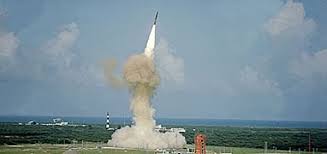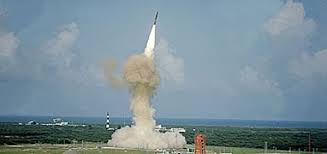
Seeking to demonstrate its nuclear arms capacity at a time of rising strategic tensions with Russia and North Korea, the U.S. military test-fired its second intercontinental ballistic missile in a week on Thursday night.
Late at night the unarmed Minuteman III missile was launched from Vandenberg Air Force Base in California and sped across the night sky at speeds of up to 15,000 mph (24,000 kph) before landing in a target area 4,200 miles (6,500 km) away near Kwajalein Atoll in the Marshall Islands of the South Pacific after half an hour.
A message to strategic rivals like Russia, China and North Korea were delivered by the U.S. tests, conducted at least 15 times since January 2011, that Washington has an effective nuclear arsenal, said Deputy Defense Secretary Robert Work, who witnessed the launch.
"That’s exactly why we do this. We and the Russians and the Chinese routinely do test shots to prove that the operational missiles that we have are reliable. And that is a signal ... that we are prepared to use nuclear weapons in defense of our country if necessary," Work told reporters before the launch.
Since the U.S. arsenal is near the end of its useful life and a spate of scandals in the nuclear force two years ago raised readiness questions, demonstrating the reliability of the nuclear force has taken on additional importance recently.
Improvement of conditions for troops responsible for staffing and maintaining the nuclear systems have been done using millions of dollars by the defense department. More focus on upgrading the weapons is being put by the administration.
With the aim of overhauling the country's aging nuclear bombers, missiles, submarines and other systems, President Barack Obama’s final defense budget unveiled this month calls for a $1.8 billion hike in nuclear arms spending.
A multiyear overhaul by the Pentagon and Energy Department, of the atomic arms infrastructure that is expected to cost $320 billion over a decade and up to 1 trillion dollars over 30 years would be made possible by the president's $19 billion request.
This is a dichotomy of sorts as Obama had made reducing U.S. dependence on atomic weapons a centerpiece of his agenda during his first years in office.
Obama reached a new strategic weapons treaty with Russia after he made a call for a world eventually free of nuclear arms in a speech in Prague. His stance on reducing atomic arms in part earned Obama the Nobel Peace Prize.
"He was going to de-emphasize the role of nuclear weapons in U.S. national security policy ... but in fact in the last few years he has emphasized new spending," said John Isaacs of the Council for a Livable World, an arms control advocacy group.
Since the Pentagon intends to build a force capable of deploying the 1,550 warheads permitted under the New START treaty, hence critics say the Pentagon's plans are unaffordable and unnecessary. However the country could further reduce its deployed warheads by a third and still remain secure, Obama has said.
The Pentagon's costly "all-of-the-above" effort to rebuild all its nuclear systems was a "train wreck that everybody can see is coming," said Hans Kristensen, an analyst at the Federation of American Scientists. The plans were "divorced from reality", said Kingston Reif of the Arms Control Association.
(Source:www.reuters.com)
Late at night the unarmed Minuteman III missile was launched from Vandenberg Air Force Base in California and sped across the night sky at speeds of up to 15,000 mph (24,000 kph) before landing in a target area 4,200 miles (6,500 km) away near Kwajalein Atoll in the Marshall Islands of the South Pacific after half an hour.
A message to strategic rivals like Russia, China and North Korea were delivered by the U.S. tests, conducted at least 15 times since January 2011, that Washington has an effective nuclear arsenal, said Deputy Defense Secretary Robert Work, who witnessed the launch.
"That’s exactly why we do this. We and the Russians and the Chinese routinely do test shots to prove that the operational missiles that we have are reliable. And that is a signal ... that we are prepared to use nuclear weapons in defense of our country if necessary," Work told reporters before the launch.
Since the U.S. arsenal is near the end of its useful life and a spate of scandals in the nuclear force two years ago raised readiness questions, demonstrating the reliability of the nuclear force has taken on additional importance recently.
Improvement of conditions for troops responsible for staffing and maintaining the nuclear systems have been done using millions of dollars by the defense department. More focus on upgrading the weapons is being put by the administration.
With the aim of overhauling the country's aging nuclear bombers, missiles, submarines and other systems, President Barack Obama’s final defense budget unveiled this month calls for a $1.8 billion hike in nuclear arms spending.
A multiyear overhaul by the Pentagon and Energy Department, of the atomic arms infrastructure that is expected to cost $320 billion over a decade and up to 1 trillion dollars over 30 years would be made possible by the president's $19 billion request.
This is a dichotomy of sorts as Obama had made reducing U.S. dependence on atomic weapons a centerpiece of his agenda during his first years in office.
Obama reached a new strategic weapons treaty with Russia after he made a call for a world eventually free of nuclear arms in a speech in Prague. His stance on reducing atomic arms in part earned Obama the Nobel Peace Prize.
"He was going to de-emphasize the role of nuclear weapons in U.S. national security policy ... but in fact in the last few years he has emphasized new spending," said John Isaacs of the Council for a Livable World, an arms control advocacy group.
Since the Pentagon intends to build a force capable of deploying the 1,550 warheads permitted under the New START treaty, hence critics say the Pentagon's plans are unaffordable and unnecessary. However the country could further reduce its deployed warheads by a third and still remain secure, Obama has said.
The Pentagon's costly "all-of-the-above" effort to rebuild all its nuclear systems was a "train wreck that everybody can see is coming," said Hans Kristensen, an analyst at the Federation of American Scientists. The plans were "divorced from reality", said Kingston Reif of the Arms Control Association.
(Source:www.reuters.com)





